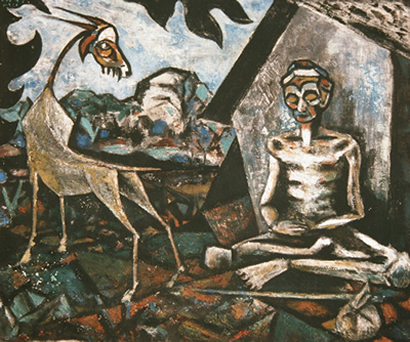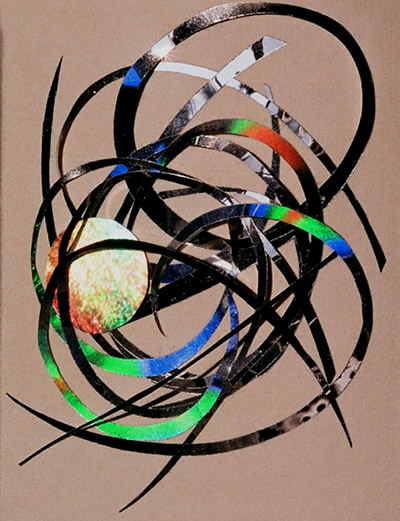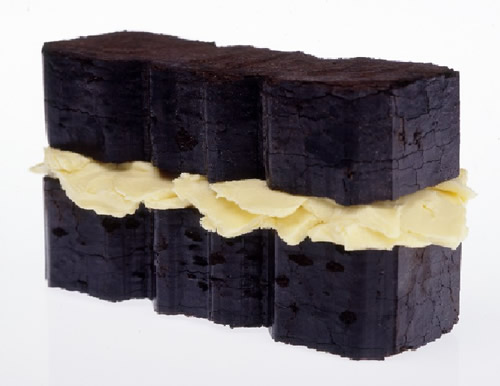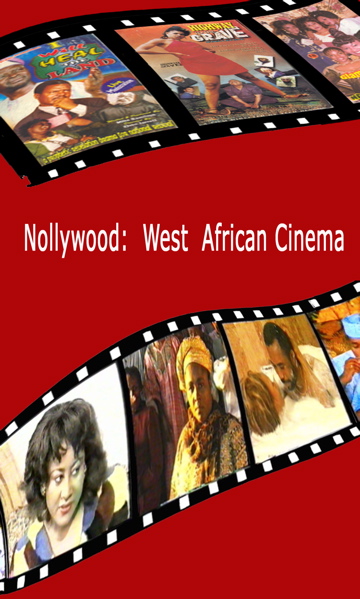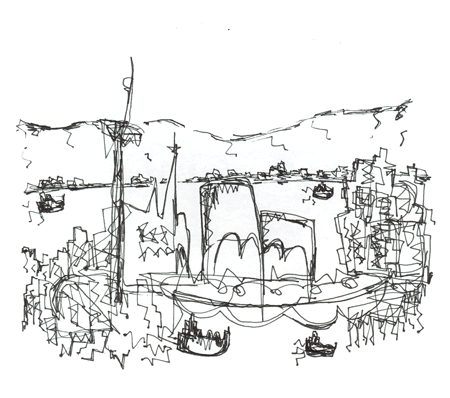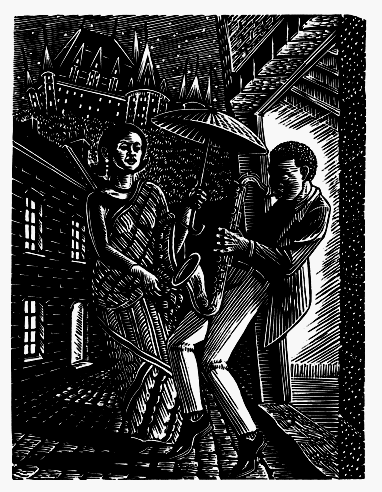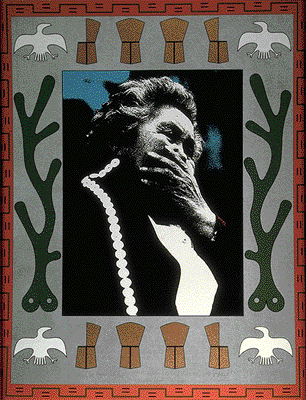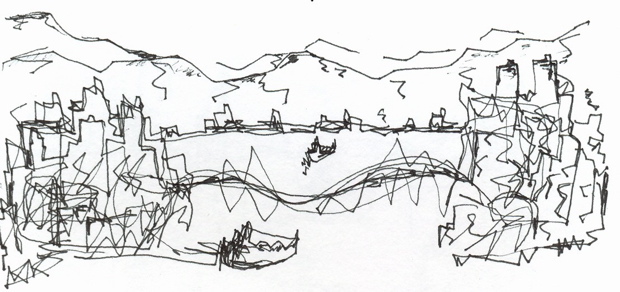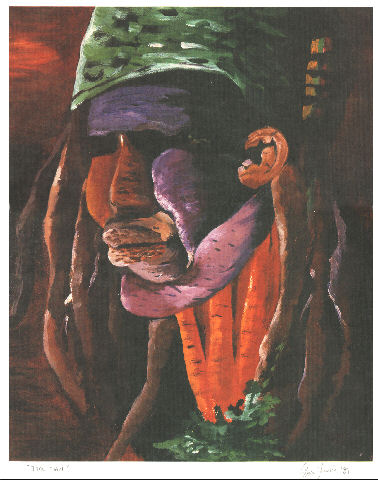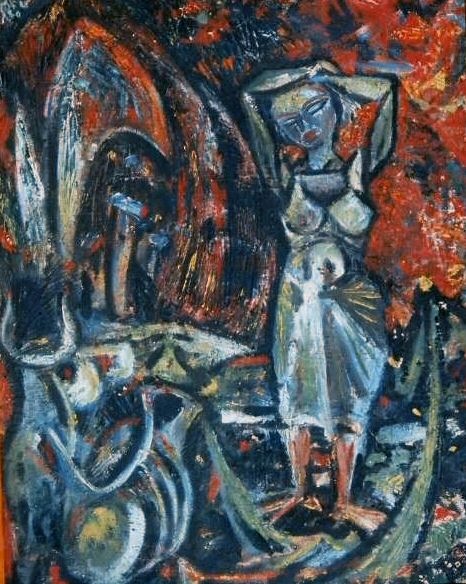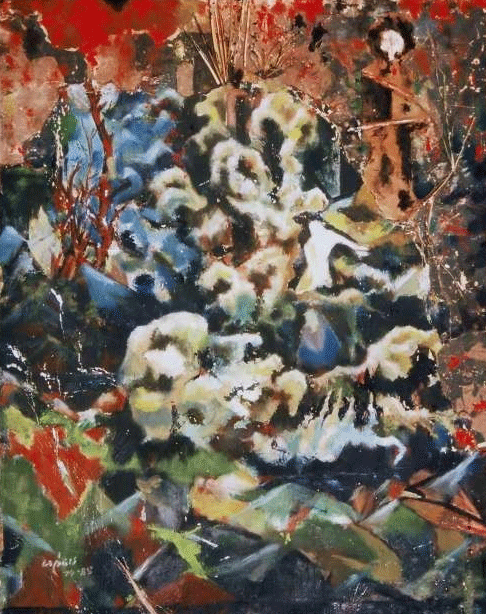2011
Vol 6, No 1 (2011)
David Revoy "Tsunami: Pictures for Japan"
Speedpainting, March 2011
2712x1386, size 924 KB
http://www.davidrevoy.com
Speedpainting, March 2011
2712x1386, size 924 KB
http://www.davidrevoy.com
2009
Vol 5, No 4 (2009)
Unknown Huichol artist, Sierra Madre Mountains, Mexico, 2000. 23 ½ inches square yarn painting attached to plywood frame with beeswax
Huichol Shamans drumming their requests to the gods and goddesses for wisdom as they care for the needs of the villagers. The deer act as the emissaries for this request.
Our thanks to Judy Butzine for her kind permission to use this artwork
Huichol Shamans drumming their requests to the gods and goddesses for wisdom as they care for the needs of the villagers. The deer act as the emissaries for this request.
Our thanks to Judy Butzine for her kind permission to use this artwork
Vol 5, No 3 (2009)
Peterson Kamwathi, untitled (Peacebrokers) charcoal on soft pastel paper; 243.8 cm by 152.4 cm
"Peacebrokers" refers to the diplomats and negotiators who mediated between the conflicting political parties in the Kenyan post-election dispute and violence, December 2007-February 2008. A selection of Kamwathi's work can be viewed at the following website: www.kamwathi.com.
"Peacebrokers" refers to the diplomats and negotiators who mediated between the conflicting political parties in the Kenyan post-election dispute and violence, December 2007-February 2008. A selection of Kamwathi's work can be viewed at the following website: www.kamwathi.com.
Vol 5, No 1 (2009)
"Talking Drums" Beaded Painting by Jimoh Buraimoh, Oshogbo, Nigeria. 1.07 MB
The Bead Museum Collection, Glendale, Arizona.
Grateful acknowledgement to Judy Butzine (Photographer)
The Bead Museum Collection, Glendale, Arizona.
Grateful acknowledgement to Judy Butzine (Photographer)
2008
Vol 4, No 2 (2008)
David Grudniski, Gridlock
oil on shaped canvas, 47x32x3 inches
Artist's statement:
"Gridlock" is my reaction to urban landscapes and how inter city people live and function. The centre, congested and primary in colour, generates a topographical grid from which flows the diagonal edges of an urban zone
(www.grudart.ca)
oil on shaped canvas, 47x32x3 inches
Artist's statement:
"Gridlock" is my reaction to urban landscapes and how inter city people live and function. The centre, congested and primary in colour, generates a topographical grid from which flows the diagonal edges of an urban zone
(www.grudart.ca)
Vol 4, No 1 (2008)
Ashley Halpé, Ascetic and Goat
Oil on canvas. 64 cms. X 53 cms. 1961.
Artist statement: "Several of my paintings juxtapose a human figure and an animal. Here the ascetic sits in trance in the classic lotus posture for meditation while the goat, tense with energy and randy-eyed, looks at him askance. The viewer is welcome to supply its thought and a theme. The painting also illustrates my liking for deep tones and jewel-like faceted shapes lit at some points as by an inner glow."
Oil on canvas. 64 cms. X 53 cms. 1961.
Artist statement: "Several of my paintings juxtapose a human figure and an animal. Here the ascetic sits in trance in the classic lotus posture for meditation while the goat, tense with energy and randy-eyed, looks at him askance. The viewer is welcome to supply its thought and a theme. The painting also illustrates my liking for deep tones and jewel-like faceted shapes lit at some points as by an inner glow."
2007
Vol 3, No 3 (2007)
Joseph Beuys' Irish Energies (reconstruction) 2007 by Sean Lynch; peat briquettes, butter; original made in 1974
On one of his frequent visits to Ireland in 1974, the German artist, Joseph Beuys constructed this, obviously fleeting, piece. Over thirty years later, one of Ireland's leading young artists, Sean Lynch, reconstructed the piece, a gesture that is consistent with Lynch's ongoing, Benjaminian, reclamation of the discarded fragments of the Irish historical landscape. It seems apposite, then, to prefigure this special Irish issue with such a 'dialogic' art work, one that speaks across an art-historical temporal continuum, as well as drawing on the critical heritage of Walter Benjamin, which has nourished so much of the output of Irish postcolonial studies.
On one of his frequent visits to Ireland in 1974, the German artist, Joseph Beuys constructed this, obviously fleeting, piece. Over thirty years later, one of Ireland's leading young artists, Sean Lynch, reconstructed the piece, a gesture that is consistent with Lynch's ongoing, Benjaminian, reclamation of the discarded fragments of the Irish historical landscape. It seems apposite, then, to prefigure this special Irish issue with such a 'dialogic' art work, one that speaks across an art-historical temporal continuum, as well as drawing on the critical heritage of Walter Benjamin, which has nourished so much of the output of Irish postcolonial studies.
Vol 3, No 1 (2007)
Christopher Kelen, View of Macao
Left Handed City Sketch, 22cmx18cm, ink on paper, 2006
Left Handed City Sketch, 22cmx18cm, ink on paper, 2006
2006
Vol 2, No 4 (2006)
Wesley W. Bates, 2003, wood block 3.5" by 4.5" published in George Elliott Clarke, Québeccité (Kentville, Canada: Gaspereau Press, 2003).
The Quebecois, however defined, are a multiracial, multilingual people, if one respects the multicultural fact of Quebec's history. Even when Quebec was Nouvelle-France, it boasted the presence of at least 5,000 slaves, some African, most Aboriginal peoples, with much intermarriage (and just plain old "shacking up") too. The cover of Québeccité illustrates that "Quebecness" (the meaning of "québeccité") signals a rainbow, not a "pure laine," identity, regardless of the racial feelings of hard nationalists.... Some folks may reject the image of the "Anglo-imperialist" Chateau Frontenac looming in the background, but too bad: it's the most photographed building in Canada; it's a world-recognized symbol of the specialness of Quebec (appearing in even governmental tourist info); and the CP Railway, its builder, was also one of the few somewhat decent employers of African-Canadian men for the first half of the last century. Oh, and I should add, it's a beautiful building.
George Elliott Clarke
The Quebecois, however defined, are a multiracial, multilingual people, if one respects the multicultural fact of Quebec's history. Even when Quebec was Nouvelle-France, it boasted the presence of at least 5,000 slaves, some African, most Aboriginal peoples, with much intermarriage (and just plain old "shacking up") too. The cover of Québeccité illustrates that "Quebecness" (the meaning of "québeccité") signals a rainbow, not a "pure laine," identity, regardless of the racial feelings of hard nationalists.... Some folks may reject the image of the "Anglo-imperialist" Chateau Frontenac looming in the background, but too bad: it's the most photographed building in Canada; it's a world-recognized symbol of the specialness of Quebec (appearing in even governmental tourist info); and the CP Railway, its builder, was also one of the few somewhat decent employers of African-Canadian men for the first half of the last century. Oh, and I should add, it's a beautiful building.
George Elliott Clarke
Vol 2, No 3 (2006)
David Neel, Trial of Tears
28 3/4 in by 22 in; serigraph.
Artist Statement
Trial of Tears depicts the precedent-setting legal action of the Gitksan/Wet'suet'en people, and the government of Canada. At a cost of 2.5 million dollars, and taking over three years, this case sought to resolve the long outstanding "land question." This important Canadian ruling laid to waste any hopes of a "reasonable compromise," and is not expected to be the "last word on this case." Amid a growing national awareness of the need to deal with Native issues, this ruling has left the land question and aboriginal rights in the same nebulous state. Leaders throughout Canada have suggested that the decision "reflects a colonial view of society toward aboriginal people," and fails "to redress past injustices and heal historical wounds." Important across Canada, this debate is of particular interest in B.C. where the majority of land does not come under any treaty or legal agreement, a situation unique in North America. After 9,200 exhibits, tens of thousands of pages of trial documents, and at great expense to both parties the land question appears no closer to resolution. The central figure is of Native elder, Mary Johnson upon hearing the outcome of the trial March 8th, 1991. It was initially a front-page photograph of the Vancouver Sun. The tree of life is representative of the territory and the resources that comprise the land question. Coppers are a traditional symbol of wealth; in a dispute a chief may "break a copper," removing a piece and present it to his adversary. There are four broken coppers to represent the legal dispute, and four whole coppers to represent the unresolved land question. The four white ravens depict the ever-changing trickster. These represent the Canadian legal system and this ruling.
28 3/4 in by 22 in; serigraph.
Artist Statement
Trial of Tears depicts the precedent-setting legal action of the Gitksan/Wet'suet'en people, and the government of Canada. At a cost of 2.5 million dollars, and taking over three years, this case sought to resolve the long outstanding "land question." This important Canadian ruling laid to waste any hopes of a "reasonable compromise," and is not expected to be the "last word on this case." Amid a growing national awareness of the need to deal with Native issues, this ruling has left the land question and aboriginal rights in the same nebulous state. Leaders throughout Canada have suggested that the decision "reflects a colonial view of society toward aboriginal people," and fails "to redress past injustices and heal historical wounds." Important across Canada, this debate is of particular interest in B.C. where the majority of land does not come under any treaty or legal agreement, a situation unique in North America. After 9,200 exhibits, tens of thousands of pages of trial documents, and at great expense to both parties the land question appears no closer to resolution. The central figure is of Native elder, Mary Johnson upon hearing the outcome of the trial March 8th, 1991. It was initially a front-page photograph of the Vancouver Sun. The tree of life is representative of the territory and the resources that comprise the land question. Coppers are a traditional symbol of wealth; in a dispute a chief may "break a copper," removing a piece and present it to his adversary. There are four broken coppers to represent the legal dispute, and four whole coppers to represent the unresolved land question. The four white ravens depict the ever-changing trickster. These represent the Canadian legal system and this ruling.
Vol 2, No 2 (2006)
Christopher Kelen, View of Macao: Harbour and Bridge
29 cm X 21 cm, ink on paper.
29 cm X 21 cm, ink on paper.
Vol 2, No 1 (2006)
Roger Ferreira, Ital Man
Roger Ferreira, a Canadian artist whose parents are from Trinidad and Tobago, graduated from St Mary's College P.O.S. and McMaster University with a B.A in the History of Art. He is a winner of the John C. Holland award for Art and Culture, and teaches art at the Immigrant Culture Art Association and "Under the Willows" of Lynwood Hall in Hamilton, Ontario.
Roger Ferreira, a Canadian artist whose parents are from Trinidad and Tobago, graduated from St Mary's College P.O.S. and McMaster University with a B.A in the History of Art. He is a winner of the John C. Holland award for Art and Culture, and teaches art at the Immigrant Culture Art Association and "Under the Willows" of Lynwood Hall in Hamilton, Ontario.
2005
Vol 1, No 2 (2005)
Ashley Halpé, Woman and Bull
47 cm x 38 cm, oil on canvas
Statement from the Artist: "The painting shows a juxtaposition, the exchange of looks unfathomable; there is a hint of the Europa theme and also an uneasy mutter of violence in the composition."
47 cm x 38 cm, oil on canvas
Statement from the Artist: "The painting shows a juxtaposition, the exchange of looks unfathomable; there is a hint of the Europa theme and also an uneasy mutter of violence in the composition."
2004
Vol 1, No 1 (2004)
Ashley Halpé, Pasan
oil and fragments of straw on canvas
board; 60 cm x 50 cm
Statement from the Artist:
"The painting is a threnody for Lanka as is my long poem of the same name. 'Pasan' means Passiontide lamentations; these are still sung by the Catholic people of the West Coast. My lamentations are for the horrors enacted in this country during the last half-century. I first became conscious of underprivilege when working with slum children as an undergraduate in the early 'fifties- the white figure at centre right is a slum child in a typical environment. The country and its writers and artists were deeply shaken by the youth insurrection of 1971 and the ruthless backlash: the skull in the centre memorializes this. The flames at the top and reflected elsewhere are in memory of the carnage of 1983. The almost faceless figure with a sub-machine gun is both terrorist and vigilante."
oil and fragments of straw on canvas
board; 60 cm x 50 cm
Statement from the Artist:
"The painting is a threnody for Lanka as is my long poem of the same name. 'Pasan' means Passiontide lamentations; these are still sung by the Catholic people of the West Coast. My lamentations are for the horrors enacted in this country during the last half-century. I first became conscious of underprivilege when working with slum children as an undergraduate in the early 'fifties- the white figure at centre right is a slum child in a typical environment. The country and its writers and artists were deeply shaken by the youth insurrection of 1971 and the ruthless backlash: the skull in the centre memorializes this. The flames at the top and reflected elsewhere are in memory of the carnage of 1983. The almost faceless figure with a sub-machine gun is both terrorist and vigilante."









